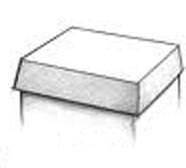

Two distinct traits of the mansard roof – steep sides and a double pitch – sometimes lead to it being confused with other roof types. Since the upper slope of a mansard roof is rarely visible from the ground, a conventional single-plane roof with steep sides may be misidentified as a mansard roof. Mansard roofs are popular with many of the townhomes in Miami Lake. The gambrel roof style, commonly seen in barns in North America, is a close cousin of the mansard. Both mansard and gambrel roofs fall under the general classification of "curb roofs" (a pitched roof that slopes away from the ridge in two successive planes). However, the mansard is a curb hip roof, with slopes on all sides of the building, and the gambrel is a curb gable roof, with slopes on only two sides. (The curb is a horizontal heavy timber directly under the intersection of the two roof surfaces.) In France and Germany, no distinction is made between gambrels and mansards – they are both called "mansards". In the French language, mansarde can be a term for the style of roof, or for the garret living space, or attic, directly within it. The Mansard style is popular in Miami Lakes and as a Miami Lakes Roofing company we are your best choice for a Roofing company. They makes maximum use of the interior space of the attic and offers a simple way to add one or more storeys to an existing (or new) building without necessarily requiring any masonry. Often the decorative potential of the Mansard is exploited through the use of convex or concave curvature and with elaborate dormer window surrounds. One frequently seen explanation for the popularity of the mansard style is that it served to shelter its owners against taxes as well as rain. One such example of this claim, from the 1914 book, How to Make a Country Place, reads, "Monsieur Mansard is said to have circumvented that senseless window tax of France by adapting the windowed roof that bears his name." This is improbable in many respects: Mansart was a profligate spender of his clients' money, and while a French window tax did exist, it was enacted in 1798, 132 years after Mansart's death, and did not exempt mansard windows. Later examples suggest that either French or American buildings were taxed by their height (or number of storeys) to the base of the roof, or that mansards were used to bypass zoning restrictions. This last explanation is the nearest to the truth: a Parisian law had been in place since 1783, restricting the heights of buildings to 20 meters (65 feet). The height was only measured up to the cornice line, making any living space contained in a mansard roof exempt.
Courtesy of: JW Roofing: We are the best Miami Roofing company.
Let JW Roofing roof or re-roof your home or business...call for an estimate today! 305-825-4207
Another kind of roof to note is Open Gable-Hip Roof.